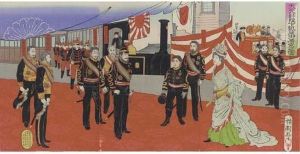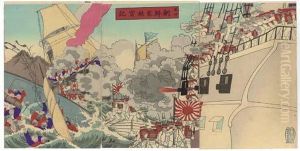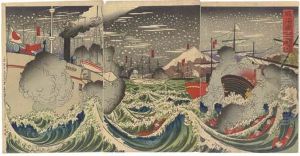Utagawa Kokunimasa Paintings
Utagawa Kokunimasa was a Japanese woodblock print artist, born in 1874 in Tokyo, Japan. He was a part of the Utagawa school, which was one of the most influential groups in the history of Japanese woodblock printing, known as ukiyo-e. The Utagawa school produced numerous artists who specialized in genres ranging from beautiful women (bijin-ga) to historical scenes (yakusha-e) and landscapes (fukei-ga). Kokunimasa, in particular, was renowned for his war prints and scenes of the Sino-Japanese War (1894-1895) and the Russo-Japanese War (1904-1905).
Kokunimasa was born as Utagawa Kunimasa V and later adopted the go (art name) Kokunimasa. He was the son of Utagawa Kuniteru II, inheriting a legacy of artistic talent and tradition. During his career, Kokunimasa contributed to the Meiji era's nationalistic fervor by creating vivid, dynamic prints that depicted Japanese military victories and heroism. His works served not only as art but also as propaganda, encouraging support for Japan's military campaigns and fostering a sense of national pride.
The artist's detailed and colorful depictions of battles, soldiers, and warships captured the imagination of the public and are considered valuable historical documents today. They provide insight into the period's military technology, uniforms, and tactics. Beyond his war prints, Kokunimasa also produced works featuring traditional subjects, including kabuki actors, landscapes, and scenes from Japanese mythology and folklore.
Despite the changing times and the decline in popularity of ukiyo-e in the face of modernization and Western influence, Kokunimasa continued to work in the traditional woodblock printing technique. His commitment to the craft and his ability to adapt traditional themes to reflect contemporary events allowed him to maintain a successful career.
Utagawa Kokunimasa passed away in 1944, leaving behind a legacy that remains significant in the study of Meiji-era art and Japanese woodblock printing. His works are held in high regard and can be found in collections worldwide, offering a window into the cultural and historical narratives of late 19th and early 20th century Japan.


